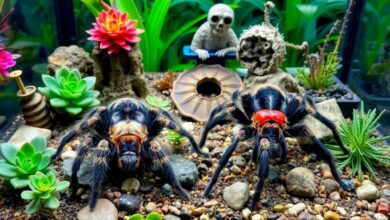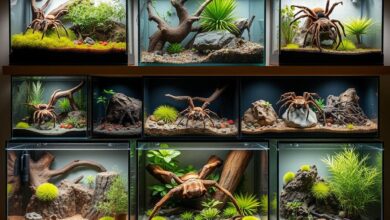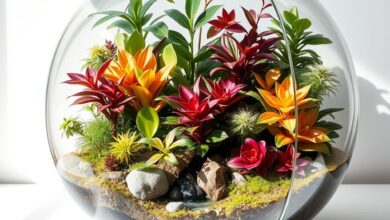The best substrates for the tarantula terrarium
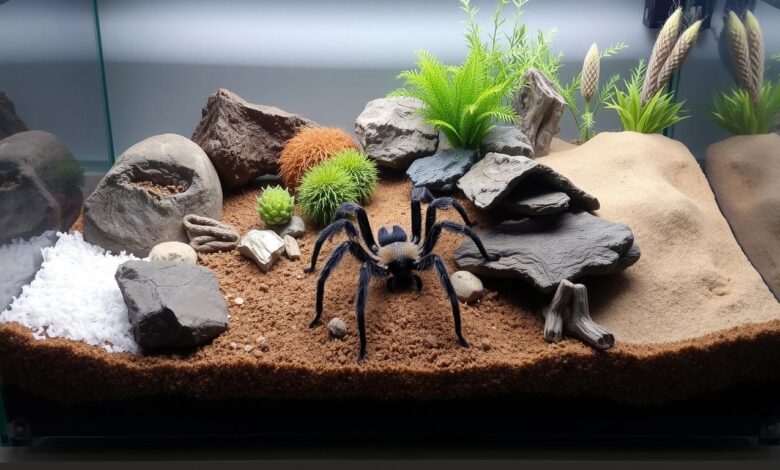
Choosing the right substrate is key to a happy tarantula. It’s important to know the different options to keep your tarantula healthy. We’ll look at top picks like coconut fiber, vermiculite, and sphagnum moss.
We’ll also talk about potting soil mixes, Eco-earth, and reptile carpets. You’ll learn how to pick the best substrate for your tarantula. Plus, how to set up a bioactive terrarium and keep the substrate clean. This guide will help you create the best home for your tarantula.
What are substrates for the tarantula terrarium?
Substrates are key for a comfy home for your tarantula. They line the terrarium’s bottom, meeting your tarantula’s needs. Popular choices include coconut fiber, vermiculite, and sphagnum moss.
Coconut Fiber
Coconut fiber is natural and keeps moisture well. It’s great for tarantulas that need the right humidity. It also lets your tarantula burrow, making a cozy spot.
Vermiculite
Vermiculite is light and absorbs moisture. It’s good for tarantulas that like dry places. It stops too much moisture from building up.
Sphagnum Moss
Sphagnum moss is a favorite for tarantula homes. It keeps moisture right and looks natural, making a great place for your tarantula to live.
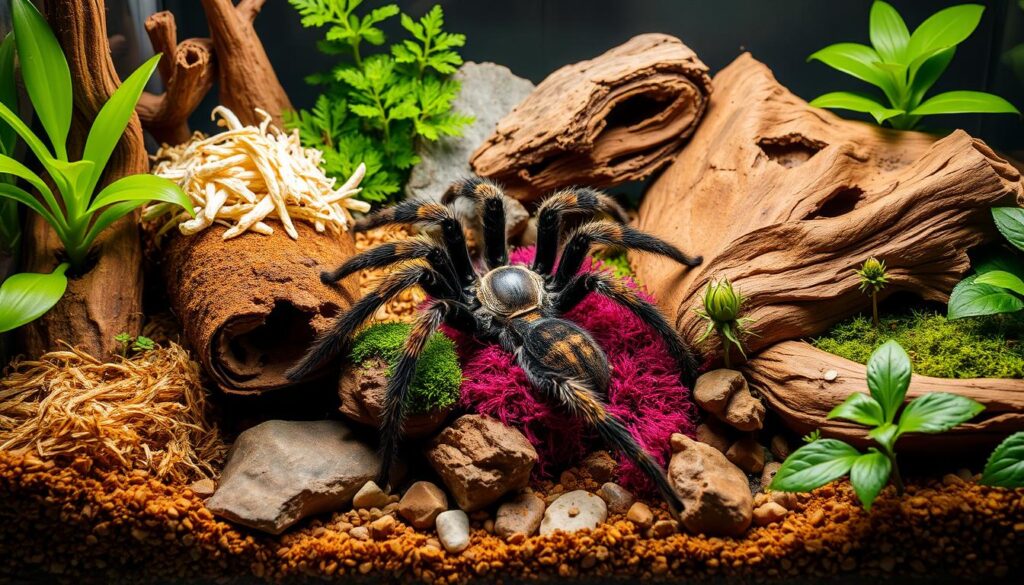
Choosing the right substrate is important. Think about moisture, burrowing, and looks. The right mix makes a happy and healthy home for your tarantula.
Popular loose particle substrates
Setting up the perfect tarantula terrarium involves choosing the right substrate. Two popular options are cypress mulch and peat moss. They offer unique benefits for your tarantulas.
Cypress Mulch
Cypress mulch is a natural, organic choice. It retains moisture well and lets tarantulas burrow. This is great for fossorial species that like to dig.
Peat Moss
Peat moss is another good option. It absorbs water, keeping humidity levels steady. This helps your tarantula thrive in its environment.
When picking substrates, think about moisture, burrowing, and your tarantula’s needs. Using these substrates can make a great habitat for your tarantula.

Substrates for the tarantula terrarium: Potting soil mixes
Potting soil mixes are a great choice for your tarantula’s home. They often have peat moss, vermiculite, and other organic stuff. These ingredients make a perfect bed for your tarantula.
These mixes keep moisture in, making a comfy spot for your tarantula to dig and live. Make sure the mix doesn’t have bad chemicals or fertilizers. Choose potting soil mixes made for tarantula terrariums or tarantula substrates.
Make sure the mix has good air flow and isn’t too tight. This lets your tarantula dig easily. Also, check the moisture often and change it if needed. This keeps the right humidity for your tarantula.
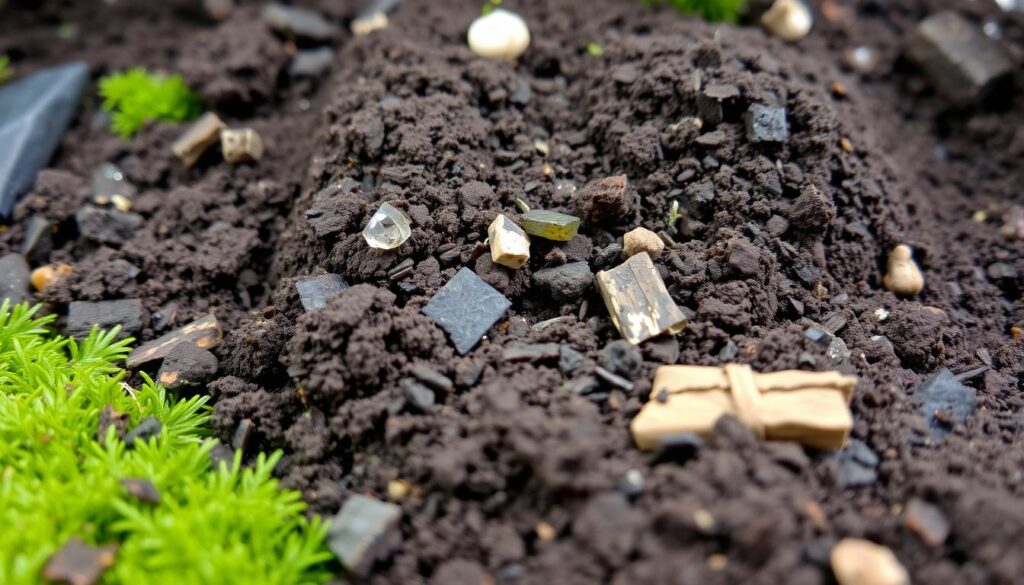
 Diseases and Treatments in Tarantulas: Common Pathologies and How to Act
Diseases and Treatments in Tarantulas: Common Pathologies and How to Act
Using a good potting soil mix in your tarantula terrarium makes a great home. Always think about your tarantula’s health when picking and caring for the substrate.
Eco-earth: A versatile substrate choice
Eco-earth, also known as coconut fiber or coir, is a top pick for tarantula terrariums. It’s natural, absorbs moisture well, and lets tarantulas burrow easily.
Eco-earth keeps the terrarium’s humidity just right. It holds onto moisture, slowly releasing it to keep the environment stable. This is great for tarantulas that love humid places.
Keeping the terrarium clean with eco-earth is a breeze. It’s easy to spot clean and refresh, perfect for those with busy schedules. You can use it alone or mix it with other substrates for the best setup.
Looking to start or update a tarantula terrarium? Eco-earth is a smart choice. It’s natural, practical, and makes your terrarium a great home for your tarantula.
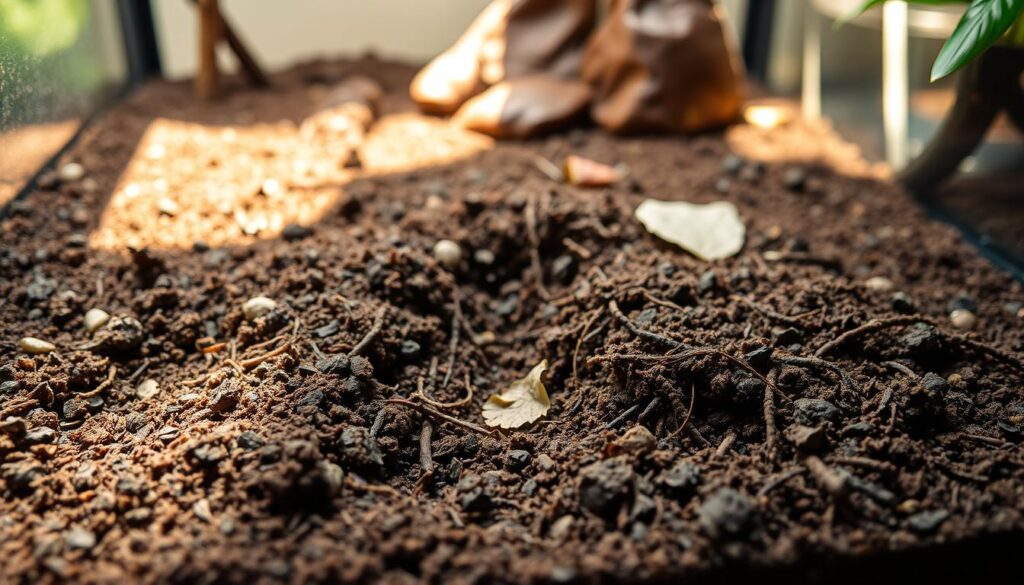
Reptile carpet: A low-maintenance option
Choosing the right substrate is key for a great tarantula terrarium. Reptile carpet is a popular choice among tarantula owners. It’s a non-abrasive material that’s easy to care for.
Reptile carpet is made for reptile enclosures. It’s different from natural substrates like coconut fiber. It’s easy to clean, just spot-clean and wipe down with a damp cloth when needed.
Reptile carpet may not look like natural substrates. But, it comes in many colors and textures. You can pick one that matches your terrarium’s decor.
One big plus of reptile carpet is its durability. It’s made to handle tarantulas’ digging and burrowing. This is great for active tarantulas that like to dig.
When picking a reptile carpet, choose a high-quality one. Look for products made for reptile habitats. Cheap or generic options might not be safe or durable for your tarantula.
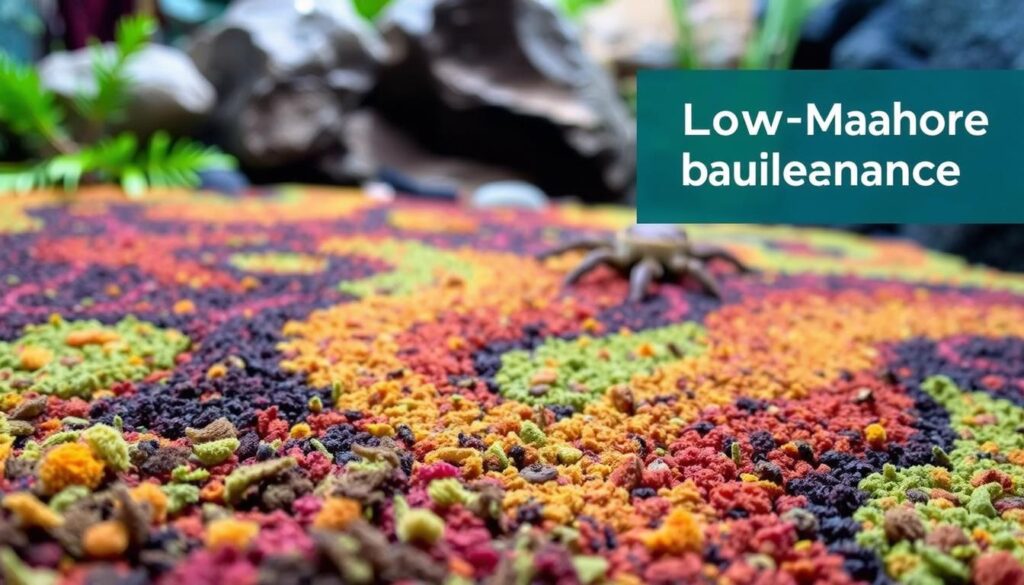
In summary, reptile carpet is a good choice for a tarantula terrarium. It’s easy to clean, looks good, and lasts long. But, make sure to pick a quality product for your tarantula’s health and happiness.
Choosing the right substrate for your tarantula
Setting up a tarantula terrarium means picking the right substrate is key. It must be comfortable for your tarantula. The substrate’s ability to hold moisture is also important for the terrarium’s humidity.
Consider the Tarantula Species
Each tarantula species has its own needs. For example, the Chaco Golden Knee Tarantula likes dry conditions. But the Goliath Bird-Eating Tarantula needs it more humid. Knowing what your tarantula needs helps pick the right substrate.
Moisture Retention Ability
The substrate’s ability to hold moisture is vital. Substrates like coconut fiber and sphagnum moss are great for humid habitats. For drier habitats, cypress mulch and peat moss are better.
Choosing the right substrate based on your tarantula’s needs and moisture preferences is crucial. It ensures a healthy and happy home for your tarantula.
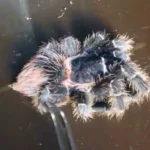 Dyskinetic Syndrome (DS) in Tarantulas: Causes, Symptoms, and Management
Dyskinetic Syndrome (DS) in Tarantulas: Causes, Symptoms, and Management
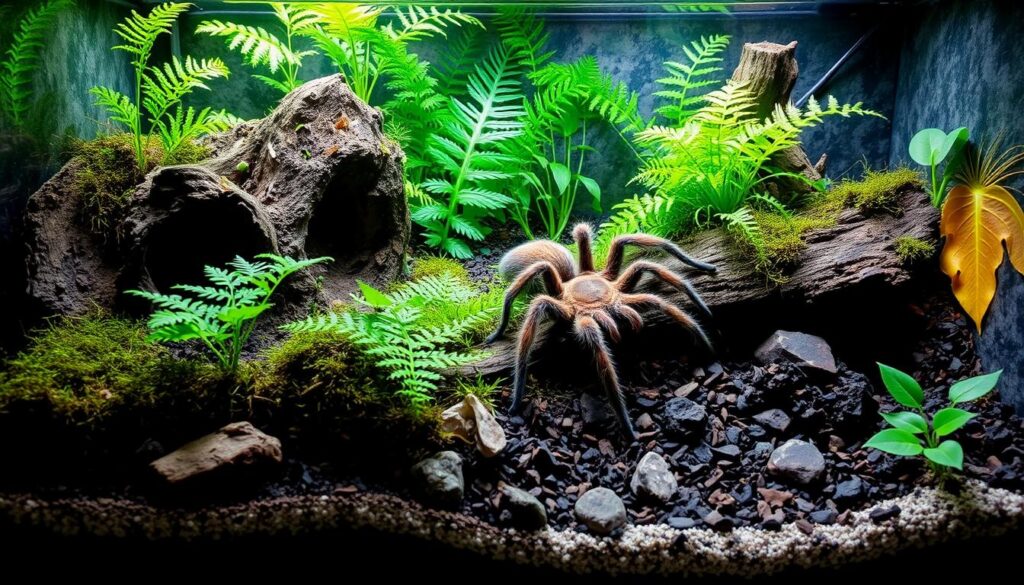
Setting up a bioactive tarantula terrarium
Creating a bioactive enclosure is a great way to make your tarantula’s home more natural. These terrariums have live plants and a “clean-up crew” of tiny animals like springtails and isopods. They help clean up, control humidity, and keep the ecosystem balanced.
Introducing springtails and isopods
Adding springtails and isopods to your tarantula’s space makes it a lively, easy-to-care-for place. It’s like their natural habitat. These small creatures are key to the bioactive tarantula terrarium and clean up after your tarantula.
- Springtails are tiny, soil-dwelling insects that eat decaying matter. They help keep the soil healthy.
- Isopods, or “pill bugs,” are crustaceans that break down plants and control moisture in the terrarium.
By adding these helpful animals to your bioactive tarantula terrarium, you create a self-sustaining world. It needs little care, letting your tarantula live in a natural, fulfilling space.

Substrates for the tarantula terrarium: Maintenance tips
Keeping the substrate in your tarantula terrarium clean is vital for your pet’s health. It’s important to clean up waste and leftover food regularly. Also, deep cleaning and replacing the substrate now and then is necessary.
Watch the moisture levels in the terrarium closely. If you see wet or moldy spots, act fast to stop harmful bacteria or fungi from growing.
When you clean or replace the substrate, use safe products. Avoid harsh chemicals or abrasives that could hurt your tarantula. Instead, choose gentle, natural cleaners. Make sure to remove all debris or contaminants well.
Substrate Maintenance Checklist
- Spot clean the substrate regularly to remove waste and uneaten food
- Perform a deep clean and replace the substrate every 2-3 months
- Monitor the moisture levels and address any wet or moldy areas promptly
- Use safe, reptile-friendly cleaning products and methods
- Ensure the new substrate matches the previous type for a seamless transition
By following these simple tips, you can keep your tarantula’s substrate in great shape. This will help create a healthy and thriving environment for your fascinating arachnid.
| Substrate Maintenance Frequency | Recommended Actions |
|---|---|
| Weekly | Spot clean to remove waste and uneaten food |
| Every 2-3 Months | Perform a deep clean and replace the substrate |
| Ongoing | Monitor moisture levels and address any wet or moldy areas |
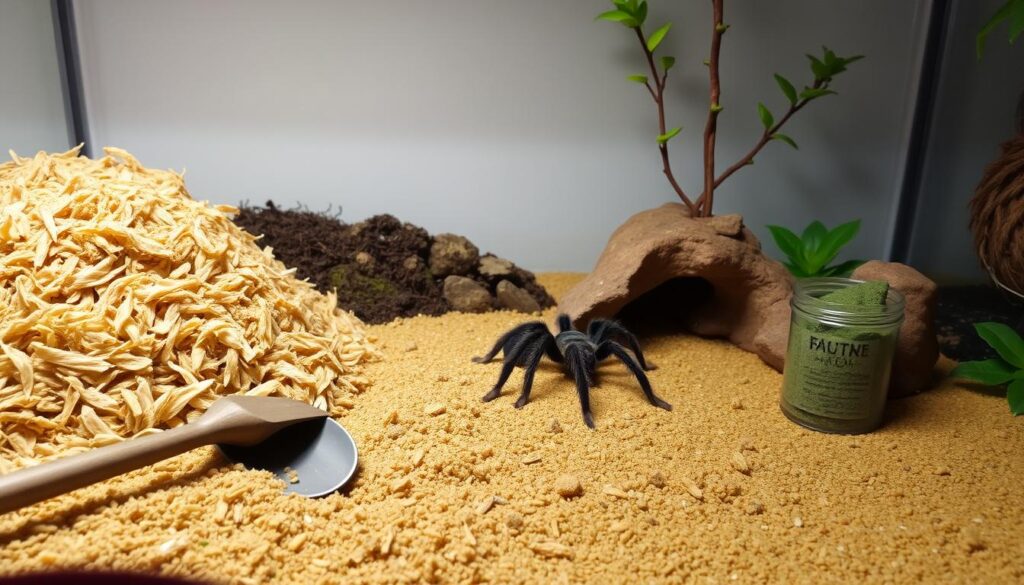
Remember, proper substrate maintenance is key to a healthy tarantula terrarium. Spend time cleaning and replacing the substrate as needed. This will give your tarantula the best living environment.
Where to buy quality substrates?
Finding the right substrates for your tarantula’s terrarium is easy when you know where to look. You can shop online or visit a local pet store. Both options have their benefits when it comes to finding quality tarantula supplies.
If you like shopping in person, many pet stores and reptile shops have a wide range of substrates. They can help you choose the best one for your tarantula. You might also find unique substrates that aren’t available online.
Online stores offer a huge selection of tarantula substrates from trusted brands. Reputable online retailers like Petco, Chewy, and Reptile City have a variety of substrates. They also provide detailed product descriptions and customer reviews to help you decide.
- For where to buy tarantula substrates, consider visiting your local pet store or exploring online marketplaces like Chewy, Petco, and Reptile City.
- Look for tarantula supplies that use natural, non-toxic materials and are specifically designed for your pet’s needs.
- Specialty pet stores and reptile shops may offer a more diverse selection of substrates, including custom blends, while online stores provide convenience and a wider range of options.

Whether you shop online or in a store, research is key. Choose substrates that will keep your tarantula safe and happy. The right substrate ensures your pet’s comfort and well-being for years.
Combining substrates for optimal results
To get the best results for your tarantula terrarium, mix different substrates. This creates the perfect habitat. You can layer or mix materials like coconut fiber, vermiculite, and sphagnum moss. This mix offers great moisture, burrowing, and is perfect for your tarantula.
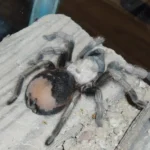 Fungal Infections, Mites, and Hair Loss in Tarantulas
Fungal Infections, Mites, and Hair Loss in Tarantulas
Start with a drainage layer of leca or rocks, separated by terrarium mesh. This ensures good air and prevents water from pooling. Then, use a mix of coconut fiber, peat moss, and sphagnum moss for the main layer. This mix holds moisture well and allows for burrowing.
Adding materials like orchid bark, lava rock, charcoal, and pumice can improve your substrate. These help with drainage and air. Also, adding earthworm castings and bat guano gives nutrients for microfauna and plants in your terrarium.

